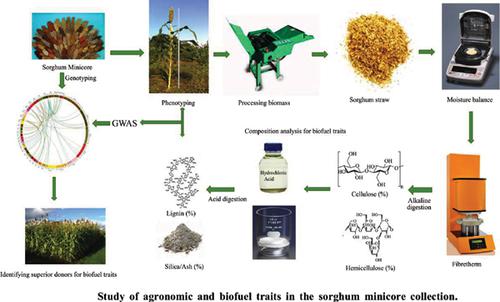Protein & Peptide Letters ( IF 1.6 ) Pub Date : 2021-07-31 , DOI: 10.2174/0929866528666210215141243 Laavanya Rayaprolu 1 , Sivasubramani Selvanayagam 1 , D Manohar Rao 2 , Rajeev Gupta 1 , Roma Rani Das 1 , Abhishek Rathore 1 , Prasad Gandham 1 , K N S Usha Kiranmayee 1 , Santosh P Deshpande 1 , Ashok Kumar Are 1

|
Background: Production of biofuels from lignocellulosic crop biomass is an alternative to reduce greenhouse gas emissions. The biofuel production involves collecting biomass, breaking down cell wall components followed by the conversion of sugars to ethanol. The lingo-cellulosic biomass comprises 40-50% cellulose, 20-30% hemicellulose, and 10-25% lignin. Sorghum is a widely adapted energy crop for biofuel production. Biomass with low lignin, high cellulose, and high hemicellulose contents are exploited to attain maximum biofuel production efficiency. Resistance to lodging, pest, disease, and abiotic stresses related to cell wall components is well documented, and quantitative trait loci were identified to understand these traits' genetic correlation. Selection for reduced lignin and increased cellulose content in stover can increase the ethanol yield. The Genome-Wide Association Studies (GWAS) is a complementary approach to evaluating the marker and phenotype associations among large diversity panels. Single nucleotide polymorphisms were scanned to identify loci associated with the traits of interest. In this study, the GWAS was performed on 245 sorghum minicore genotypes to analyze agronomic traits (days to 50%flowering, fresh biomass yield, dry biomass yield) and cell wall components (cellulose, hemicellulose, and lignin). Further, in-silico validation of the candidate genes was performed in a global gene expression data from large-scale RNA sequencing studies in sorghum available in the NCBI GEO database was used.
Objective: The objectives of this study are to evaluate native variations in biofuel related agronomic traits and stalk cell wall components and to identify significant SNPs or loci related to the cell wall components.
Methods: In this article, an association mapping panel, comprising of 245 sorghum minicore germplasm accessions, was evaluated during two post rainy seasons of 2013 and 2014, and observations were recorded on the whole plot- for days to 50% flowering, fresh biomass yield (tha-1), and dry biomass yield (tha-1). The biomass of sun-dried plants from both seasons was collected separately, chopped, dried, and ground to powder. The cellulose, hemicellulose, and lignin contents were determined in the powdered. The content of each of these three components in sorghum was expressed in percent of dry matter. The data on agronomic traits and composition analysis was subjected to Analysis of Variance. For the current study, we remapped the raw GBS data with the sorghum assembly version v3.1. A total of 27,589 SNPs were obtained with a minor allele frequency (MAF) >1% and missing data <50%. The GWAS was performed in a single minicore population using FarmCPU, in R software. The synteny positions of the identified significant SNPs between sorghum and other model crop species viz., maize, switchgrass, and Arabidopsis were represented using CIRCOS software for traits viz., dry biomass yield, cellulose, hemicellulose, and lignin. The transcriptome dataset from where sorghum gene atlas studies of grain, sweet, and bioenergy sorghums are available through NCBI's Gene Expression Omnibus (GEO) under accession number GSE49879, was used to cross-validate the identified SNPs for cellulose, hemicellulose, and lignin through GWAS.
Results: High broad-sense heritability was exhibited for all the traits in individual seasons along with significant genotype × environment interaction across seasons except lignin. Association mapping with a P < 1×10-4 revealed genomic regions associated with the- (i) agronomic traits (days to 50% flowering, fresh and dry biomass), and (ii) biochemical traits (cellulose, hemicellulose, and lignin) associated with biofuels production, in individual seasons. Twelve significant SNPs for flowering time, 30 fresh biomass yields, and 24 for dry biomass yield, 25 for cellulose, 7 for hemicellulose, and 21 for lignin were identified. CIRCOS plot was constructed to identify and analyze similarities and differences while comparing the sorghum genome with different crops. For cellulose high similarity of >80% was observed for all sorghum gene sequences with the maize homologs. The overall similarity of sorghum homologs with foxtail millet was >65%, for Arabidopsis from 30.6% to 48.6%, and rice from 28.2% to 92.8%. SNPs for hemicellulose displayed maximum similarity to foxtail millet followed by maize. The sequence similarity of lignin SNPs in sorghum was highest with the maize genome followed by Arabidopsis. Both rice and foxtail millet showed >55% similarity to the sorghum genome.
Conclusion: This study reports large variability for agronomic and biofuel traits in the sorghum minicore collection with high heritability. The genetic architecture of cell wall components using the GWAS approach was studied and candidate genes for each component were annotated. These results give a better understanding of the genetic basis of the sorghum cell wall composition. The association analysis identified regions of the genome that could be targeted to enhance the quality of biomass and yield along with the desired composition promoting breeding efficiency for enhanced biofuel yield.
中文翻译:

使用 Minicore 收集的高粱中主要生物燃料性状的全基因组关联研究
背景:从木质纤维素作物生物质生产生物燃料是减少温室气体排放的一种替代方法。生物燃料生产包括收集生物质、分解细胞壁成分,然后将糖转化为乙醇。木质纤维素生物质包含 40-50% 的纤维素、20-30% 的半纤维素和 10-25% 的木质素。高粱是一种广泛适用于生物燃料生产的能源作物。具有低木质素、高纤维素和高半纤维素含量的生物质被用来获得最大的生物燃料生产效率。对与细胞壁成分相关的倒伏、病虫害、疾病和非生物胁迫的抗性有充分的记录,并且确定了数量性状基因座以了解这些性状的遗传相关性。在秸秆中选择减少木质素和增加纤维素含量可以提高乙醇产量。全基因组关联研究 (GWAS) 是一种评估大型多样性面板之间标记和表型关联的补充方法。扫描单核苷酸多态性以鉴定与感兴趣的性状相关的基因座。在这项研究中,GWAS 对 245 个高粱微型核心基因型进行了分析,以分析农艺性状(开花天数达到 50%、新鲜生物质产量、干生物质产量)和细胞壁成分(纤维素、半纤维素和木质素)。此外,使用 NCBI GEO 数据库中可用的高粱大规模 RNA 测序研究的全局基因表达数据对候选基因进行了计算机验证。全基因组关联研究 (GWAS) 是一种评估大型多样性面板之间标记和表型关联的补充方法。扫描单核苷酸多态性以鉴定与感兴趣的性状相关的基因座。在这项研究中,GWAS 对 245 个高粱微型核心基因型进行了分析,以分析农艺性状(开花天数达到 50%、新鲜生物质产量、干生物质产量)和细胞壁成分(纤维素、半纤维素和木质素)。此外,使用 NCBI GEO 数据库中可用的高粱大规模 RNA 测序研究的全局基因表达数据对候选基因进行了计算机验证。全基因组关联研究 (GWAS) 是一种评估大型多样性面板之间标记和表型关联的补充方法。扫描单核苷酸多态性以鉴定与感兴趣的性状相关的基因座。在这项研究中,GWAS 对 245 个高粱微型核心基因型进行了分析,以分析农艺性状(开花天数达到 50%、新鲜生物质产量、干生物质产量)和细胞壁成分(纤维素、半纤维素和木质素)。此外,在 NCBI GEO 数据库中可用的高粱大规模 RNA 测序研究的全局基因表达数据中对候选基因进行了计算机验证。扫描单核苷酸多态性以鉴定与感兴趣的性状相关的基因座。在这项研究中,GWAS 对 245 个高粱微型核心基因型进行了分析,以分析农艺性状(开花天数达到 50%、新鲜生物质产量、干生物质产量)和细胞壁成分(纤维素、半纤维素和木质素)。此外,使用 NCBI GEO 数据库中可用的高粱大规模 RNA 测序研究的全局基因表达数据对候选基因进行了计算机验证。扫描单核苷酸多态性以鉴定与感兴趣的性状相关的基因座。在这项研究中,GWAS 对 245 个高粱微型核心基因型进行了分析,以分析农艺性状(开花天数达到 50%、新鲜生物质产量、干生物质产量)和细胞壁成分(纤维素、半纤维素和木质素)。此外,使用 NCBI GEO 数据库中可用的高粱大规模 RNA 测序研究的全局基因表达数据对候选基因进行了计算机验证。
目的:本研究的目的是评估生物燃料相关农艺性状和茎细胞壁成分的天然变异,并确定与细胞壁成分相关的重要 SNP 或位点。
方法:在本文中,在 2013 年和 2014 年两个雨季后评估了由 245 份高粱微型核心种质组成的关联作图面板,并记录了整个地块的观察结果 - 开花天数至 50%,新鲜生物量产量(tha -1 ) 和干生物量产量 (tha -1)。两个季节的晒干植物的生物量分别收集、切碎、干燥并研磨成粉末。测定粉末中的纤维素、半纤维素和木质素含量。高粱中这三种成分的含量均以干物质的百分比表示。对农艺性状和成分分析的数据进行方差分析。对于当前的研究,我们使用高粱组装版本 v3.1 重新映射了原始 GBS 数据。总共获得了 27,589 个 SNP,次要等位基因频率 (MAF) > 1%,缺失数据 <50%。GWAS 是在 R 软件中使用 FarmCPU 在单个微型核群体中执行的。高粱和其他模式作物物种(即玉米、柳枝稷、使用 CIRCOS 软件表示拟南芥和拟南芥的性状,即干生物量产量、纤维素、半纤维素和木质素。通过 NCBI 的 Gene Expression Omnibus (GEO) 以登录号 GSE49879 可获得谷物、甜高粱和生物能源高粱的高粱基因图谱研究的转录组数据集,用于通过 GWAS 交叉验证已识别的纤维素、半纤维素和木质素的 SNP .
结果:除木质素外,各个季节的所有性状均表现出较高的广义遗传力,以及跨季节显着的基因型×环境相互作用。具有 P < 1×10 -4 的关联映射揭示了与(i)农艺性状(开花天数至 50%、新鲜和干生物量)和(ii)与生物燃料生产相关的生化性状(纤维素、半纤维素和木质素)在各个季节相关的基因组区域。鉴定了 12 个与开花时间相关的重要 SNP、30 个新鲜生物质产量、24 个干生物质产量、25 个纤维素、7 个半纤维素和 21 个木质素。构建 CIRCOS 图以识别和分析高粱基因组与不同作物的异同。对于与玉米同源物的所有高粱基因序列,对于纤维素观察到>80%的高度相似性。高粱同源物与谷子的总体相似性>65%,拟南芥为 30.6% 至 48.6%,水稻为 28.2% 至 92.8%。半纤维素的 SNP 与谷子表现出最大的相似性,其次是玉米。高粱中木质素 SNP 的序列相似性在玉米基因组中最高,其次是拟南芥。水稻和谷子与高粱基因组的相似性均大于 55%。
结论:本研究报告了具有高遗传力的高粱微型核收集中农艺和生物燃料性状的巨大变异性。使用 GWAS 方法研究了细胞壁成分的遗传结构,并对每个成分的候选基因进行了注释。这些结果可以更好地了解高粱细胞壁组成的遗传基础。关联分析确定了基因组的区域,这些区域可以作为提高生物燃料质量和产量的目标,以及促进育种效率以提高生物燃料产量的所需组成。



























 京公网安备 11010802027423号
京公网安备 11010802027423号